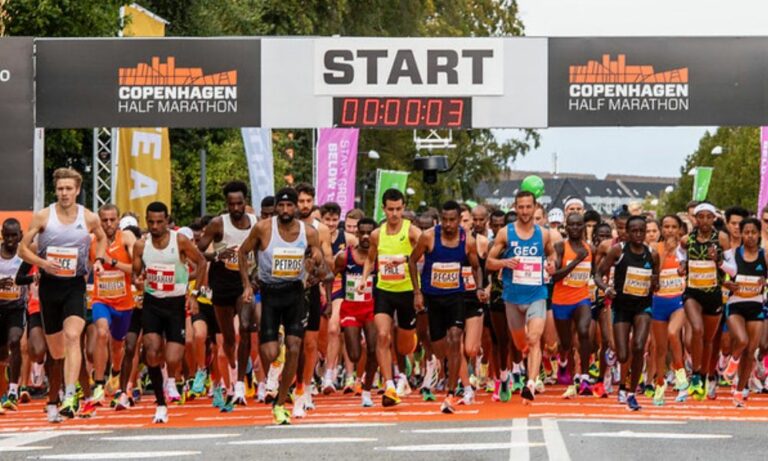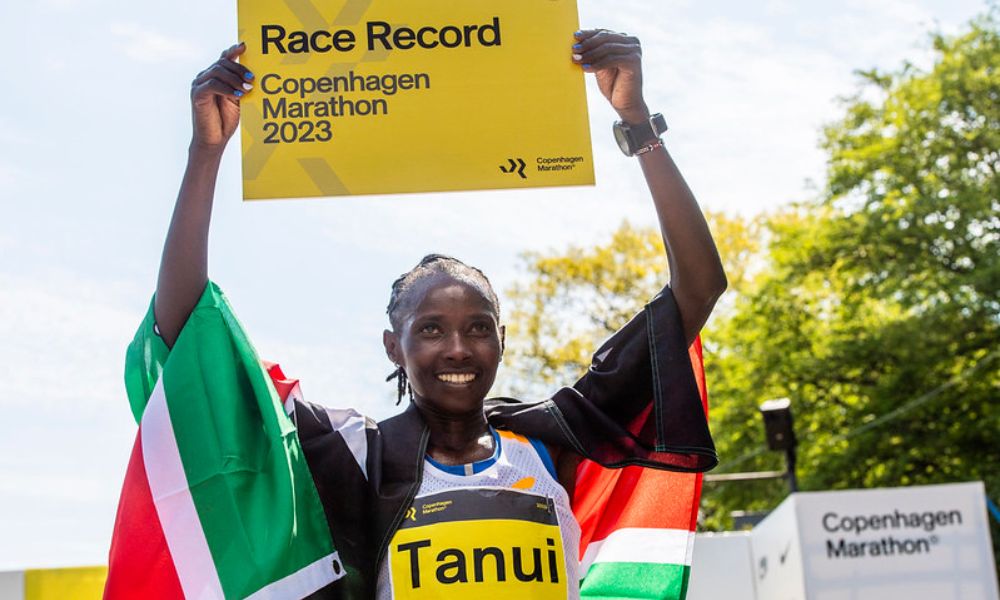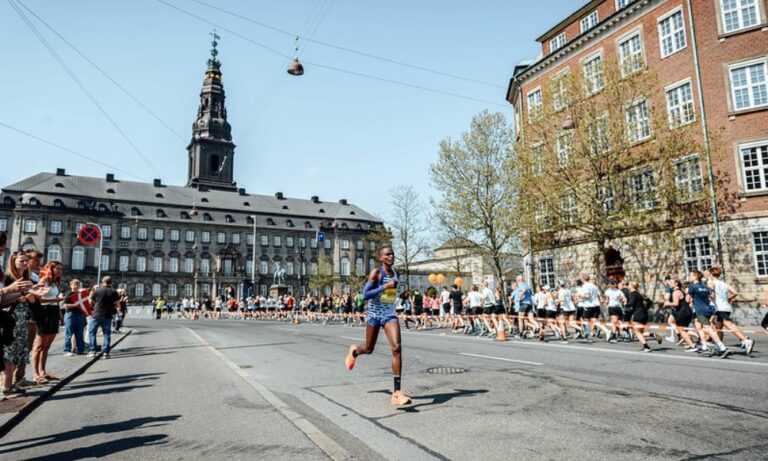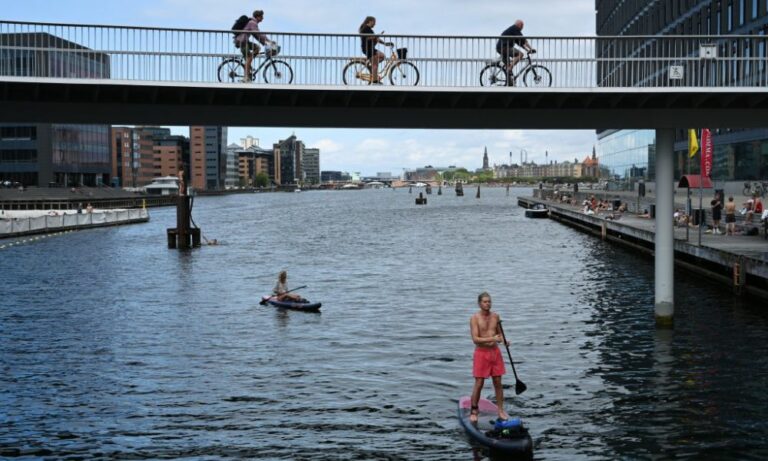
In the week the city lodged a bid for the 2026 World Athletics Road Running Championships, SportsPro speaks to Surf and SUP Danmark and Sparta Atletik & Motion to find out why Copenhagen’s harbour and other landmarks make it an unforgettable destination for visiting athletes.
The city, which holds the title of the Unesco-UIA World Capital of Architecture for 2023, has become a landmark destination for sporting events. It hosted the start of the 2022 Tour de France and houses more than one million citizens, with many embracing sport as part of their daily lifestyles.
Already a popular destination for international tourists, Copenhagen’s harbour has undergone a number of changes over the years, transitioning from its industrial roots to a regular host of watersports. In 2024, the Danish capital will stage the International Surfing Association’s (ISA) World Stand-Up Paddling (SUP) and Paddleboard Championships, marking the second time it has welcomed the event.
According to Michael Lindberg, head of secretary at Surf and SUP Danmark, the city is a good fit for the international occasion.
“The architecture of the harbour is made so you can actually get around the whole inner city by using the water,” he tells SportsPro. “You can see the city from the water’s perspective. And you will get around in different channels to see different parts of the city.
“Over the past ten to 15 years, in terms of trying to connect the city better than it was before, they have built a lot of bridges only for cyclists and walking. So not for cars, but a lot of bridges that connect the area. You can connect the different parts of the city and get around.
“We also use in the harbor what we call buses on water, which you see in a lot of other cities. You have a ship that can take people from one part [of the city] to another part very easily, instead of going through the whole city with a car.
“We see [it] as quite similar to stand-up paddling, which means that it’s a perfect place to showcase how you can get around in a big city.”
Lindberg also points out that Copenhagen’s previous hosting of the ISA World SUP and Paddleboard Championships in 2017 played a central role in driving some important changes at the harbour.
“In 2017, you were not even allowed to stand-up paddle in the harbour,” he continues. “There was just a small designated area, which was not owned by the harbour. That was actually one of our main points of doing the stand-up paddle event in 2017, because we had been pushing for six or seven years at that point to make SUP allowed inside the harbour.
“Then in 2019, we finally got it through that you were allowed to stand-up paddle in the whole harbour. And the municipality has also been working hard to have this strategy of how to actually make Copenhagen a place where you can be active on water. By & Havn [the company which develops the port of Copenhagen] are very eager to help a lot and to not only manage it, but also develop the harbour.
“All the parties are working together, they want things to happen, even though there are a lot of interests in the harbour.”
Why Copenhagen is an ideal destination for runners
Copenhagen has also established itself as a destination for runners and recently lodged a bid to host the 2026 World Athletics Road Running Championships, which sees races take place across the one mile, five kilometre and half marathon distances.
The city has a rich history in road races. In 1980, Sparta Athletics and Running set up the first Copenhagen Marathon, which drew 995 competitors to take part. The event’s early years saw runners move in and around car traffic on the course, with one year even forcing participants to wait for the Langebro bridge to come down before resuming the event.
Since then, the event has become increasingly popular, with more than 12,000 runners covering 104 different nationalities signed up for the 44th edition this year. People are drawn to the half and full marathon because it is considered to be a flat, fast course. The race also takes place almost exclusively within the inner city, meaning competitors are not forced out into industrial estates and are well supported by Copenhageners, who can easily access the event.
Sparta is also in charge of the Copenhagen Half Marathon, which was first held in 2015. Its has quickly become a popular race on the calendar, with this year’s race selling out three months before it takes place in September. About 25,000 runners are expected to run, with the course’s fast nature meaning world records are regularly broken in the Danish capital.

Lindberg also points out that Copenhagen’s previous hosting of the ISA World SUP and Paddleboard Championships in 2017 played a central role in driving some important changes at the harbour.
“In 2017, you were not even allowed to stand-up paddle in the harbour,” he continues. “There was just a small designated area, which was not owned by the harbour. That was actually one of our main points of doing the stand-up paddle event in 2017, because we had been pushing for six or seven years at that point to make SUP allowed inside the harbour.
“Then in 2019, we finally got it through that you were allowed to stand-up paddle in the whole harbour. And the municipality has also been working hard to have this strategy of how to actually make Copenhagen a place where you can be active on water. By & Havn [the company which develops the port of Copenhagen] are very eager to help a lot and to not only manage it, but also develop the harbour.
“All the parties are working together, they want things to happen, even though there are a lot of interests in the harbour.”
Why Copenhagen is an ideal destination for runners
Copenhagen has also established itself as a destination for runners and recently lodged a bid to host the 2026 World Athletics Road Running Championships, which sees races take place across the one mile, five kilometre and half marathon distances.
The city has a rich history in road races. In 1980, Sparta Athletics and Running set up the first Copenhagen Marathon, which drew 995 competitors to take part. The event’s early years saw runners move in and around car traffic on the course, with one year even forcing participants to wait for the Langebro bridge to come down before resuming the event.
Since then, the event has become increasingly popular, with more than 12,000 runners covering 104 different nationalities signed up for the 44th edition this year. People are drawn to the half and full marathon because it is considered to be a flat, fast course. The race also takes place almost exclusively within the inner city, meaning competitors are not forced out into industrial estates and are well supported by Copenhageners, who can easily access the event.
Sparta is also in charge of the Copenhagen Half Marathon, which was first held in 2015. Its has quickly become a popular race on the calendar, with this year’s race selling out three months before it takes place in September. About 25,000 runners are expected to run, with the course’s fast nature meaning world records are regularly broken in the Danish capital.
“There are two things that [the runners] highlight,” explains Dorte Vibjerg, administrative director and chief executive of Sparta Atletik & Motion. “The main thing is the city, its beautiful streets, its beautiful buildings. They also highlight that everything is nearby. You can go to the metro and travelling from your hotel to the start and finish points only takes ten minutes.
“Also, they mention the audience. There are so many people out there on the course, so are cheered all the way around the course. Last summer, we had the Tour de France in Copenhagen, there were 600,000 people. This year, after the Tour de France, more and more people are coming out, cheering on these sports events in the streets of Copenhagen.”
Lined with flags and surrounded by greenery, Frederiksberg boulevard is one of the more iconic parts of the course, which also passes through inner city landmarks like Radhusplasen, Tivoli and Hans Christian Andersen’s Boulevard, as well as the Nørrebro, Vesterbro and Østebro neighbourhoods.
While the marathon has become an annual highlight in Copenhagen, Vibjerg also points out that the city is the ideal setting for a run at any time of the year.
“In Copenhagen, we have a lot of good running possibilities, both paths by the lakes and by the harbour,” she says. “I think that when you are coming here as a tourist, you can enjoy that it’s very easy to go out from your hotel, and you will not be lost. And there’s always a green park nearby to do your training.
“I think that’s all also a big part of how you choose where to go for your marathon, that some days beforehand you can actually go out and have a nice and safe and enjoyable run in the city.”

How the city’s urban spaces are encouraging people to be active
Since SUP was legalised in the harbour in 2019, Lindberg says interest in the sport has grown significantly. That has naturally benefitted the only SUP sports club that existed when the new legislation was introduced but has also led to the creation of new clubs.
“They [the club] were really happy, and it [the rule change] did a lot for their club, because now they could actually start doing trips inside the harbour, which is way more attractive than just being placed outside of the city,” he explains.
“Then we got a new club very close to the inner harbour. There are some other clubs in the southern part and the northern part of the harbour that has developed with stand-up paddling. So all the clubs have more opportunities now to attract members, because the harbour is open for stand-up paddling.
“Then you have all the self-organised people that buy stand-up paddleboards. We built more and more apartments and buildings that are very close to the water because it’s very attractive. So those guys that live there, they have access to the water and can stand-up paddle around in the whole harbour.”
Similarly, Vibjerg has seen an upward trend in the number of citizens going out for a run in the city, as well as a higher number of runners taking part in events. She cites the Covid-19 pandemic as a reason for the increase in participation, as well as the growing popularity of the Royal Run, which was initially held as a one-off event to celebrate the country’s crown prince Frederick’s 50th birthday, but has now become an annual occasion where participants walk or run over three distances.
“We see that every year new runners are growing out of that event,” Vibjerg says. “30 per cent of the runners in that event have never participated in a running event. So it’s a growth of the market, and we also see an increase in the number of participants in our half marathon because of the Royal Run.
“Also after coronavirus, we really have seen an increase in people running. This year, we were sold out three months before for the half marathon and we are now increasing the number of participants. Also for our relay, we will also increase the number this year.
“It’s also because Copenhagen is a very easy place to run because you can run both morning and night. It’s very safe, there’s always light, you can even do it in the middle of the night. So I think that’s a big part of it too.”

Bringing international events to Copenhagen
When the ISA SUP World Championships return to Copenhagen next year, Lindberg says the event will showcase how the harbour can be used accessibly. An open SUP race for the public is planned for at least 1,000 participants and the hosts also plan to show how the competition can be held sustainably in the harbour.
“What we really hope is that anyone can see that being on the water is a great physical activity,” Lindberg states. “It’s fun, it’s easy, it’s accessible. Then, the other part is more environmental, because there is a big focus on this for the event.
“We know that stand-up paddle championships may not create the biggest volume of people, but having the people there see ways that you can work more sustainably is one of the goals as well.
“We are also looking into different options to do cleanups of the harbour together with a French company that use sea bins that you put down into the water and collect all the garbage, all the plastic that has been thrown into the water, into the harbour.
“Even though Copenhagen is quite a clean city, there’s a lot of trash in the water. So during the event, we are also going to do public open cleanups of the harbour water and also on land. That is something that we also hope will put some interest into people’s heads about the environment and sustainability.”
As well as on water, Copenhagen also hopes to bring world-leading runners to the city through its bid to host the 2026 World Athletics Road Running Championships. It previously staged the World Half Marathon Championships in 2014, but Vibjerg points out that the 2026 event would instead feature races across the one mile and five-kilometre distances, as well as the half marathon.
“Instead of having 30,000, we actually aim to have 65,000 participants across all three distances,” she states. “So that’s a very high number, and it’s also the highest number that has ever participated in a World Championship. That’s what we are actually trying to tell World Athletics, that we can increase the number of participants in their event.
“So if you participated in 2014, this will be an even bigger experience than back then.”

